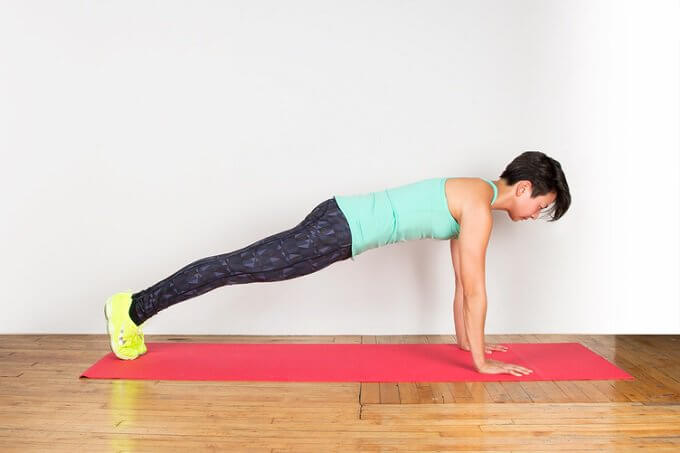6 Exercises to Tone Your Back


Written and verified by the doctor Karla Henríquez
The purpose of toning the back is to achieve a good appearance, and also to improve posture. To achieve this goal, it is necessary to follow a proper exercise routine and to be perseverant.
As with all physical training, results are not immediate. It takes some time to get what you want. Therefore, you shouldn’t give up during the process!
When they first start an exercise routine, it is normal for people to focus on the abdominal area and limbs. However, it is also important to tone your back. Why? Because a strong back ensures good support and less pain.
When toning the back, you can achieve good posture. This, without a doubt, will improve your physical appearance and well being.
Learn to tone your back
1. Plank (push-ups)

Push ups are one of the best exercises. This movement works on the upper muscles by pushing and pulling on the back. The legs must move together. You should feel tension in your abdomen, but it is not necessary to hold your breath. Keep your back straight to avoid unnecessary strain in that area.
In this exercise, the body is suspended in the air as you support yourself on only your arms and feet. Your legs and back must form a straight line. Stretch one arm backwards, alternating one at a time.
You can add a medium weight to each arm as you gain more resistance. Start with 20 seconds, and then increase the time as you feel comfortable.
We recommend: 5 Stretches to Naturally Relieve Back Pain
2. Resistance bands
Resistance bands, or exercise bands, are elastic bands useful in almost all workouts. In addition, you can take them (and use them) anywhere. They provide a greater range of movements (up, down, sideways, angles) to stimulate specific muscles.
Sit in a chair and place the center of the resistance band under your buttocks. Hold the band and pull up. Bend your elbows so that your hands reach behind your neck. With the palms of your hands up, pull until you fully extend the band. Lower it slowly and repeat as many times as possible in 60 seconds.
Do this twice a week for a month to begin to get results.
3. Push, pull, and lift

You can tone your back easily with simple movements. Your muscles are activated every time you open or close a door, lift an object, turn the steering wheel, and even when you shower.
To tone your back, you can perform weight lifting exercises. These include lifting dead weights in certain positions (all with a straight back) and trying to balance the weight itself. The best thing about this type of exercise is that it helps work your buttocks, hamstrings, quadriceps, forearms, shoulders, and abdominals.
4. Stretching
When your back muscles are contracted, you tend to hunch more. This can even affect your spine. To avoid this, you must stretch the shortened muscles, the chest, and the arms.
Try to work on your flexibility. Perform stretching exercises, even if only for 10 minutes. Place your arm at a 90 degree angle against a door frame. Turn your body towards your other arm and stretch for 30 to 60 seconds, then change sides. Repeat 3 times, and you’ll notice that your back feels better.
5. Use your entire back

Many times, all you need to do to tone your back is to use your own body weight. To sculpt and strengthen the back, we suggest you perform the classic “Superman” move, which works both the upper and lower back.
To do this exercise, you must lie face down on the floor. Lift both legs and arms from the floor at the same time. Hold this posture for 10 seconds, then release.
Repeat this exercise as many times as possible in 60 seconds. Do it three times per week to get better results.
Remember, you should take some time to relax between exercises. This way, you avoid accumulating tension and injuring yourself.
6. Maintain correct posture
Half of the process to having a strong back is accomplished by maintaining correct posture. Try to be aware of your posture both while standing and sitting.
All cited sources were thoroughly reviewed by our team to ensure their quality, reliability, currency, and validity. The bibliography of this article was considered reliable and of academic or scientific accuracy.
- Chou, R., Qaseem, A., Snow, V., Casey, D., Cross, J. T., Shekelle, P., … Owens, D. (2007). Diagnosis and treatment of low back pain: A joint clinical practice guideline from the American College of Physicians and the American Pain Society. Annals of Internal Medicine, 147, 478-491
annals.org/article.aspx?articleid=736814&issueno=7&atab=10 - Daul, R. (2005). Easy exercise program for low back pain relief
spine-health.com/wellness/exercise/strengthening-exercise-program-low-back-pain-relief - Van Tulder, M., Malmivaara, A., Esmail, R., & Koes, B. (2000). Exercise therapy for low back pain: A systematic review within the framework of the Cochrane Collaboration Back Review Group. Spine, 25(21), 2784-2796
luzimarteixeira.com.br/wp-content/uploads/2010/07/exercise-therapy-for-low-back-pain.pdf
This text is provided for informational purposes only and does not replace consultation with a professional. If in doubt, consult your specialist.








